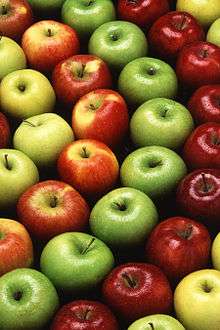Cooking apple
A cooking apple, culinary apple, or apple is an apple that is used primarily for cooking, as opposed to a dessert apple, which is eaten raw. Cooking apples are generally larger, and can be tarter than dessert varieties. Some varieties have a firm flesh that does not break down much when cooked. Culinary varieties with a high acid content produce froth when cooked, which is desirable for some recipes.[1] Britain grows a large range of apples specifically for cooking. Worldwide, dual-purpose varieties (for both cooking and eating raw) are more widely grown.
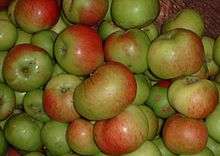
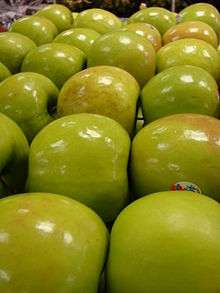
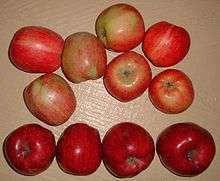
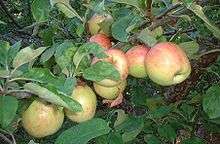
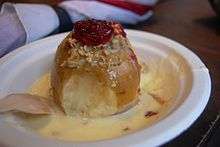
Apples can be cooked down into sauce, apple butter, or fruit preserves. They can be baked in an oven and served with custard, and made into pies or apple crumble. In the UK roast pork is commonly served with cold apple sauce made from boiled and mashed apples. Bramley apple is by far the most popular cooking apple in the United Kingdom, while Granny Smith may be the most popular in the United States and Australia (where it originated).[2]
A baked apple is baked in an oven until it has become soft. The core is usually removed and the resulting cavity stuffed with fruits, brown sugar, raisins, or cinnamon, and sometimes a liquor such as brandy. An apple dumpling adds a pastry crust.
John Claudius Loudon wrote in 1842:[3]
Properties of a good apple — Apples for table are characterised by a firm pulp, elevated, poignant flavour, regular form, and beautiful colouring; those for kitchen use by the property of falling as it is technically termed, or forming in general a pulpy mass of equal consistency when baked or boiled, and by a large size. Some sorts of apples have the property of falling when green, as the Keswick, Carlisle, Hawthornden, and other codlins; and some only after being ripe, as the russet tribes. Those with this property when green are particularly valuable for affording sauces to geese early in the season, and for succeeding the gooseberry in tarts.
Cooking apple cultivars
- Antonovka
- Arthur Turner
- Baldwin
- Ballyfatten
- Baron Ward[4]
- Beacon
- Belle de Boskoop
- Bismarck apple
- Black Amish – also consumed as an eating apple[5]
- Blenheim Orange [6]
- Bloody Ploughman
- Bountiful
- Bramley [7]
- Crab apple (primarily for jelly)
- Calville Blanc d'hiver
- Campanino
- Carolina Red June
- Carter's Blue
- Catshead
- Charles Ross
- Chelmsford Wonder
- 'Cortland'
- Coul Blush
- Custard
- Duchess of Oldenburg
- Dudley Winter
- Dumelow's Seedling
- Edward VII [8]
- Emneth Early
- Esopus Spitzenburg
- Gennet Moyal
- George Neal
- Glockenapfel
- Ginger Gold
- Golden Noble
- Golden Pippi
- Gragg
- Gravenstein [9]
- Granny Smith – also consumed as an eating apple
- Grenadier
- Harrison Cider Apple
- Howgate Wonder
- Irish Peach
- Isaac Newton
- James Grieve – also consumed as an eating apple
- Jonathan – also consumed as an eating apple
- Jumbo
- Keswick Codlin
- Lane's Prince Albert[6]
- Lodi[9]
- Lord Derby
- Maiden Blush
- Malinda
- McIntosh – also consumed as an eating apple
- My Jewel
- Newell-Kimzey (aka Airlie Red Flesh)
- Newton Wonder
- Nickajack
- Norfolk Biffin
- Northern greening [10]
- Northern Spy [9]
- Peasgood's Nonsuch
- Pink Lady – also consumed as an eating apple
- Pinova
- Porter's
- Pott's Seedling
- Pumpkin Sweet apple
- Red Astrachan
- Red Prince
- Reverend W. Wilks
- Rhode Island Greening
- Rome Beauty[9][11]
- Sandow [9]
- Scotch Bridget
- Scotch Dumpling
- Stirling Castle
- Smokehouse
- Snow apple (aka Fameuse) [9]
- Spartan
- Stayman
- Tickled Pink
- Tolman Sweet
- Tom Putt
- Topaz
- Twenty Ounce
- Wagener
- Warner's King
- White Melrose
- White Transparent
- Wolf River [12]
- York Imperial
References
- The new Oxford book of food plants|Vaughan & Geissler
- http://dish.allrecipes.com/apples/
- Loudon, J.C. (1842), The Suburban Horticulturist; Or, an Attempt to Teach the Science and Practice of the Culture and Management of the Kitchen, Fruit, and Forcing Garden to Those who Have Had No Previous Knowledge Or Practice in These Departments of Gardening, London: William Smith, p. 529
- Robert Hogg: The Fruit Manual.... 2nd ed. (London: 1862). Retrieved 22 February 2016.
- Fertig, Judith M. (2011). Prairie Home Cooking. Houghton Mifflin Harcourt. p. 69. ISBN 1558325824.
- Thomas, Harry Higgott (1902). The Book of the Apple. J. Lane. pp. 71.
- Mulvihill, Mary (2003). Ingenious Ireland. Simon and Schuster. p. 135. ISBN 0684020947.
- DK Publishing (contributor) (2012). Cooking Season by Season. Penguin. p. 335. ISBN 1465405186.
- Platt, Rutherford (2014). 1001 Questions Answered About Trees. Courier Dover Publications. p. 169. ISBN 048616781X.
- Weathers, John (1901). A Practical Guide to Garden Plants. Longmans, Green. pp. 1056–1059.
- Knox County Farm Bureau Bulletin. The Bureau. 1922. p. 6.
- Gordon, Don. Growing Fruit in the Upper Midwest. U of Minnesota Press. p. 47. ISBN 1452901066.
